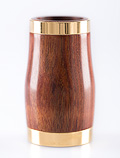The Choice of Wood
Your clarinet’s wood is more than just a vessel for the built-in mechanical features. It is the clarinet’s resonance body and influences the final instrument’s sound character greatly.
The types of wood we use all possess different surface structures which affect the way the sound waves are being reflected within the instrument. Meaning, the resulting overtones vary in intensity. The process is comparable to the workings of an equalizer, up- and downregulating the basses, middles and highs which can at times change a recording’s sound entirely.
The physically measurable differences in sound are, however, considerably smaller than the psychoacoustic differences - the playing feel. Some types of wood reverberate further into the room, while others resonate primarily in the body, allowing for the player to better hear himself.
Besides the choice of wood, the number of tone holes and their positioning, as well as the bore, are vital factors for the instrument’s sound character. For further information on this topic please click here.
We put a great amount of effort and care into choosing the right wood for your dream instrument. Using our proven technology, we achieve greatest dimensional tolerance and are able to provide you with your desired sound spectrum and ease of play.
Our clarinets are available in the following types of wood:

Grenadilla Wood (Dalbergia Melanoxylon) from Mozambique
Grenadilla wood has been used since the end of the 19th century/ the beginning of the 20th century, and is quite possibly the most popular wood used in clarinet building. In the past, it was easily acquirable in high quantities, as well as good quality which made it ideal for quick, dimensionally accurate, mass production. This particular wood has one of the highest densities. The fundamental tone, as well as the high frequencies are less dominant, whereas the middles are transported rather well. The result is a compact, centred sound.


Boxwood (Buxus sempervirens) from France and Turkey
Since the invention of the clarinet over 300 years ago, boxwood has been used in instrument making. However, since the beginning of the 20th century, due to industrial production and the ability to import exotic wood from various colonies, its usage has decreased over time. Furthermore, the amount of boxwood needed, was hardly available, due to its rather slow growth. Our experience in replicating historical clarinets, as well as the audibly different properties of boxwood, have led us to building modern clarinets from this fantastic wood, as well.
Instruments made from boxwood display a vastly flexible, rich sound, even in extreme dynamics (loud tones & quiet tones) and extreme pitches (high & low). This makes for a more expressive play, without declines in volume or focus.
Up until now (2019), we have built more than 200 clarinets from boxwood, varying in models and tunes – trend rising. Most of all, this optically rather elegant instrument, impresses by transporting the most subtle dynamics beautifully clear.


"Mopane" (Colophospermum mopane) from Simbabwe, Sambia and the Republic of South Africa
Since we first used mopane in hand crafting our instruments in 2007, it has been conquering the world of clarinets by having its own unique voice. So far, this type of wood is only known by its African name around here. In density and weight, it can be compared to Grenadilla wood which is known as Mpingo in Africa. Their shared origin explains certain similarities, however, Mopane displays a different fibre structure and colour than Grenadilla. After the oxidation and oiling process, the wood’s colour turns dark red / reddish brown.
It is not only astonishingly beautiful to look at, but produces a sound that impresses players and audience members alike. Tonally, Mopane can be found, metaphorically speaking, halfway between Grenadilla and boxwood. In its compactness it resembles boxwood which, however, allows for an even greater dynamic range. It reverberates further into the room than Grenadilla, creating a full sound which makes for a wonderful playing feel. By having such versatile tonal properties, Mopane wood develops its own unique, powerful voice.


Cocobolo (dalbergia retusa) from South America
Cocobolo has a looser fibre structure, which makes it particularly suitable for deep sounding instruments. Therefore, we mainly use it in building basset horns and bass clarinets. Its sound is less compact, while being slightly softer and immensely colourful, thereby creating a unique, interesting character which many musicians favour.

As versatile as the different types of wood, are the ways in which our instruments can be used, and the perception of the players using them. That’s why the best way of finding the right fit for you, is trying different models and comparing them. If you would like to make an appointment, please click here. We will gladly help you in person!